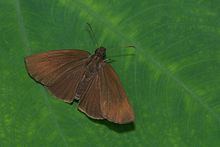Family Hesperiidae Genus Psolos Order Butterflies and moths | Subfamily Hesperiinae Scientific name Psolos fuligo Rank Species | |
 | ||
Similar Koruthaialos, Notocrypta paralysos, Notocrypta, Cupitha, Hyarotis adrastus | ||
Psolos fuligo, commonly known as the coon, is a butterfly belonging to the family Hesperiidae. The tips of the forewing diverge outward and is a feature that is clear when they rest on vegetation.
Contents
Description
The coon is a small butterfly with a wingspan of 36 to 46 millimetres (1.4 to 1.8 in). Both sexes look alike, excepting that the male has a prominent brand on the under forewing. It is a plain brown coloured butterfly on the upperside. Underneath, the butterfly is similarly coloured but paler. There are diffused greyish-purple markings on the tip of the under forewing and a series of pale spots in spaces 4 to 9. Similarly spots can be seen on the under hindwing in spaces 2 to 7 and at the end cell.
Distribution and status
The butterfly ranges from India to Southeast Asia and the Indonesian archipelago.
India forms the western boundary of the coon with the butterfly found in the Western Ghats in peninsular India, and from Assam to Arunachal Pradesh, other states of the northeast India and into Bangladesh and southern Myanmar. In southeast Asia, the coon flies in Thailand, Malaysia, Singapore, northern and southern Vietnam, Laos, Philippines, and possibly southern China. In the Indonesian archipelago, the coon flies in Borneo, Java, Sumatra, Sipora, Bali, Palawan, Sulawesi and Banggai.
The butterfly is common in India.
Subspecies
There are three subspecies:
Natural history
The butterfly is a weak flier which prefers to stay low and frequent shady nooks or grassy patches in forested areas. Often seen perched on leaves. The characteristic identification of this butterfly is that the tips of the forewings of the butterfly remain spread apart even when the wings are closed.
The recorded food plants of the larva are all from family Marantaceae:
The subfamily Aroidaea (family Araceae) has also been recorded as a food plant for west Malaysia.
